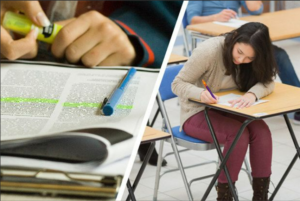Reading comprehension tests always has been a hard time for me. However, I found terrific sources on the internet and started to study hard effectively. As I could see some improvements in reading comprehension from these tips, I want to share some tips for Reading Comprehension as Final / Diploma exams are approaching. And, of course, I am not an expert in Reading comprehension; all these tips are approved tips from Khan academy. I have condensed it for the sake of the blog, but if you go to the Khan academy site, they have much more tips, so I highly encourage you to look at it. Those website can be found at the end of this blog in the resource section! I also added some specific examples from a problem set to help you understand more about these strategies, so I hope you enjoy it!

Before Reading the Passage:
Read the title and the blurb- Before Reading.
It is an essential step that will give you background information about the Passage, like the setting (where and when), character, and context. It will also let you know the Passage’s summary in advance and the author’s argument about a specific topic.
Knowing the basic plot before reading the Passage will let you understand more when you are reading. Also, it will make you not confused about the author’s main argument as, in most cases, the author’s main argument can be found in the blurb. Even if it is a literature passage, knowing the setting, character, and context will allow you to anticipate the plot correctly and make you more clear about the Passage.
Read the questions first!
Take a survey step before reading a passage. You don’t have to take a long time for this. There are some tips before reading about what kind of questions you have to read more carefully before actually reading the Passage.
Find a keyword – Before Reading!
Ex) The author indicates which of the following about the use of screen-based technologies?
This kind of question is very common, asking about what the author says about a certain topic in the Passage. In this case of question, highlight or circle that “certain topic” as a keyword. In this question, that certain topic is “the use of screen-based technologies” or “screen-based technology” highlight this in question and keep it in mind when you are reading the Passage. It will be much more effective than reading a whole passage before keeping in mind the keyword, and you have to reread it because you didn’t keep that keyword in mind to find an answer. You can solve that question much easier when you see that keyword in the Passage.
Another example for finding a keyword prior to Reading: The author of passage 2 refers to the novel War and Peace primarily to suggest that Woody Allen.
The keyword for this question is War and Peace and Woody Allen. During Reading, when you find those keywords, read carefully around that sentences and go back to the question and try to solve it!
Highlight the word!- Before Reading
Here, the word comes from the question like, “As used in line 40, ‘plastic’ most nearly means”
For this question, highlight the “plastic” and go to line 40 to emphasize that word. Fast process! It doesn’t take that much time, but it will make you look carefully and focus more on that word when you are reading.
Knowing some keywords in the question before Reading will allow you to anticipate what will happen in the Passage and have some focus points in the Passage.
However,
Do not care about questions like -Before Reading:
ex) which choice provides the best evidence for the answer to the previous question?
1) line 34-45 “xxxxxxx”
2) line 3-6 “yyyyyyy”
3) line 29-30 “zzzzz”
ex2) The main purpose of each Passage is to….
ex3)Which choice best describes the relationship between the two paragraphs?
You can skim through it, but don’t take much time for these questions before reading. Because it does not have any keywords that will help you understand the Passage before Reading, and you can only solve it after reading a whole passage or solving a last question.
During Reading:
During Reading, grab a pen because there are a few things to do to solve questions and understand passages more accurately.
Highlight the keyword – During Reading
When you see some important keywords related to the topic, author’s argument, and/or character’s POV / significant action, highlight those! It will make you understand the key points in the plot and make it easier when you are solving the question, as the question asks about the central issue in most cases.
Mark it with your symbol – During Reading
Ex) If the author is arguing and has a positive aspect, mark it with plus sign (+) next to it, and if the author is arguing with a negative aspect, mark it with minus sign (-) next to it. Therefore, when the question asks about the author’s arguments and intentions, you can easily find those points in the Passage with the eye-catching symbol next to the text. If you find an important character, circle it, find an important point underline it and when you find evidence that supports the important point, mark it with an arrow to show the relationship between the point and evidence.
Making and marking it with a symbol is not a rule that you have to follow with those specific symbols. You can use your own that fits you the most. However, make sure that it doesn’t consume your time that much!
After Reading -Practical Strategies for the common question!
You might have seen a question like:
“As used in line 40, “plastic” most nearly means.”
a)Creative
b)artificial
c)malleable
d)sculptural
There are a few strategies, too, that will make your life much easier.
When there is a sentence that contains that certain word, for example,
If this is line 40, ” We know that the human brain is highly plastic; neurons and synapses change as circumstances change.”
Tip 1) cross out the word “We know that the human brain is highly plastic.” and try to put your own word!
For example, based on the evidence that the brain has “neurons and synapses change as circumstances change” in the Passage, we can infer that the brain is somewhat changeable. When we put that word in the original sentence, “We know that the human brain is changeable; neurons and synapses change as circumstances change.” Our own word, “changeable,” perfectly fit that sentence. So, we have to find a word that is synonymous with changeable in the option!
1) Creative -> Yes, the human brain is creative, but this sentence is mostly about emphasizing the ability of the brain that can change, so we can cross out this choice.
2) Artificial -> Hmm. The human brain itself is not artificial, so we can cross out this choice right away!
3) Malleable-> Yes! It is what we are looking for. Malleable exactly mean it is changeable. This is the right answer. HOWEVER, when you do not know the definition of this word, look over the last option.
4)Sculptural-> It means unchangeable, like a statue, so this is not an answer. THEREFORE, when you don’t know a certain word, then look over other choices. If those three do not make sense at all, number three is the correct answer. HOWEVER, if there is a potential choice and another choice with a fancy word, PUT THAT POTENTIAL CHOICE. The test maker wants to confuse us with the fancy word as it seems like it is an answer because it is “fancy.” In most cases, that fancy word is not an answer. Believe in yourself and put that potential answer and the fancy word as an answer when all three other choices are definitely wrong.
The second way to solve that problem is to put each word in the sentence and checking it. Understanding what the sentence is intending (in this case, the brain is changeable) is still a key point of this strategy, but we have already done with the first strategy. Therefore we will skip that part of finding what the author is arguing with that sentence, but when you know what the author is claiming, put each option to replace “plastic” and find the right answer.
2) How to solve the “main purpose” of the Passage?
Definitely the most common type of question in Reading Comprehension tests. There are three simple steps to follow for this kind of question.
1) reread the title to recall the author’s intentions
2) Summarize each paragraph with one sentence
3) Compare each paragraph and describe how each paragraph is related.
These steps will encourage you to fully understand the Passage and the primary purpose (aka author’s intention).
3) RIP RAP!
RIP RAP is an acronym for Rephrase If Possible, Read Around and Predict. If there is a question that is asking for the relationship between paragraphs, or if there is a question with this format,” __xx______ primarily to suggest that…..”, RIP RAP is a good strategy.
Firstly, rephrase the sentence, like “x character” loves doing this and hates doing that. The author disagrees with xx argument and yy character is a good example for rephrasing too. When you rephrase a specific part, it will gain your ability to comprehend. After that, read around and predict the answer.
These are a few tips for reading comprehension. You can find much more advice, videos, and practice questions on these sites (below in the source section! + they are free too). I hope you do well on your reading comprehension test, whether it is a final or diploma exam! Good luck!
Resources:
reading practice questions: * Practice Dashboard | SAT | Khan Academy
Lecture videos for strategies : SAT strategy archive: Reading and Writing | Test prep | Khan Academy
Image source:


